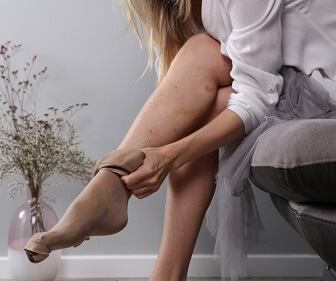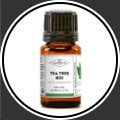The phenomenon of heavy legs, characterized by dull pain, heaviness and swelling in the ankles and calves, affects on average one in two women and one in five men. It is mainly caused by a venous circulation disorder, in other words, a poor return of blood from the lower legs to the heart.
How does this phenomenon occur? What are the causes and symptoms? Find in this file all the answers to your questions, our simple and effective natural remedies based on essential oils as well as our advice to improve your daily life.


Circulatory massage oil against heavy legs with essential oils
Why we like it: complete and effective synergy, it is perfect for those for whom the action of massaging is important and provides long-lasting relief.
Ingredients :
- 100 ml d'macadamia vegetable oil
- 10 drops ofvirginia cedar essential oil
- 15 drops ofrosemary camphor essential oil
- 20 drops ofpatchouli essential oil
Preparation: mix all the ingredients in a measuring bottle, shake it well to homogenize the preparation. It's ready !
How to use it :
apply a few drops of the synergy in the evening on the legs, massaging from bottom to top (from the ankles to the knees).Caution: not recommended for pregnant or breastfeeding women, people with epilepsy, hypertension and children under 8 years old. Estrogen-like effect: do not use in cases of mastoses or hormone-dependent cancers.

Fresh gel with essential oils against heavy legs and swollen feet
Why we love it: super effective and very fresh, it's perfect after a long summer day. It penetrates quickly and therefore does not require long massages.
Ingredients :
- 10 ml d'peppermint hydrosol
- 90 ml of sterilized water
- 2g guar gum
- 5 ml d'calophyll vegetable oil
- 10 drops ofpeppermint essential oil
- 20 drops ofcypress essential oil
- 25 drops ofisocide
Preparation: in a bowl, pour 10 ml of peppermint hydrosol and 90 ml of sterilized water. Then sprinkle the guar gum in a fine rain. Mix instantly using an electric mixer or a mini whisk to avoid the formation of lumps, until you obtain a very uniform gel.
Then add 5 ml of calophyll vegetable oil, 10 drops of peppermint essential oil, 20 drops of cypress essential oil and 25 drops of isocide for preservation. Mix again until all the ingredients are perfectly absorbed into the gel.
How to use it :
massage the legs in the evening with a nut of this gel from the feet towards the knees (that is to say in the direction of blood return) for an instant freshening effect.Precaution: do not use on sensitive areas of the body or over a large area to avoid a generalized shivering effect. Do not use in cases of mastoses and hormone-dependent cancers. Do not use in pregnant or breastfeeding women, in children under 12 years of age and in people with epilepsy or hypertension. No prolonged use without medical advice.

Anti-heavy legs foot bath with essential oils
Why we like it: easy to prepare, this foot bath is a good alternative to massage creams and oils with which it can also be easily combined. Bonus: This recipe also relieves swollen feet.
Ingredients :
- 200g sel d'Epsom
- 20 drops ofspearmint essential oil
- 20 drops oflemon eucalyptus essential oil
- 5 g d'pink clay
Preparation: mix the clay and Espom salt. Then add the essential oils, drop by drop, and disperse them evenly within the clay-Epsom salt mixture. Fill a jar with your preparation.
How to use it :
carry out your foot baths in cold or lukewarm water. Use one tablespoon of the preparation for 5 liters of water. Let your feet rest for 15 to 20 minutes before rinsing with cold water.Precaution: do not ingest. Do not use peppermint essential oil instead of spearmint to avoid an excessive ice cube effect. Not recommended for pregnant and breastfeeding women and children under 8 years old.

Tonic cream with essential oils against venous insufficiency
Why we like it: very effective, this toning cream is pleasant to apply, it does not stick and gives off a very pleasant smell. Between gel and oil, it offers a real compromise.
Ingredients :
- 37 ml d'peppermint hydrosol
- 9 ml d'cry jojoba
- 3 g cutine
- 0,15 grammes baking soda
- 2 drops ofcypress essential oil
- 4 drops ofrosewood essential oil
- 12 drops ofisocide
- 4 drops of vitamins E
Preparation: pour the jojoba oil and cutina into a first bowl. Mix lightly. In a second bowl, pour the peppermint hydrosol and the baking soda. Heat the 2 bowls in a bain-marie without stirring. As soon as the cutina has completely melted, remove the bowls from the water bath, wait another minute and pour the aqueous phase (hydrosol) into the oily phase (jojoba oil). Beat vigorously with a whisk for at least 5 minutes to obtain a homogeneous and creamy texture. Finally add the essential oils, vitamin E and isocide. Mix again then pour the mixture into a pot. Let cool.
How to use it :
apply a dab of cream morning and evening by massaging onto the calves and ankles from bottom to top to encourage blood flow. For greater efficiency, keep the preparation in the fridge for a “chill” effect.Precaution: do not use on sensitive areas of the body or over an area that is too large to avoid a generalized shivering effect. Do not use in cases of hormone-dependent mastoses and cancers. Do not use in pregnant or breastfeeding women, children under 8 years old and people with epilepsy. No prolonged use without medical advice.
Contraindications:
Essential oils are generally not recommended for pregnant women (during the entire pregnancy), breastfeeding women and children under 8 years old (12 years old for certain essential oils). Carefully read the contraindications for each essential oil.
These properties and methods of use do not constitute medical advice. For therapeutic use consult a doctor.

Why do we have heavy legs?
A little physiology: the phenomenon of “heavy legs” mainly comes from chronic venous insufficiency, the venous return of blood from the lower limbs to the heart is impaired. Discomfort and heaviness then appear in the calves, often making walking difficult and painful.
In a normal situation, this venous return occurs thanks to the contraction of the calf muscles and the muscles surrounding the veins. Valves located in the veins prevent blood from flowing downwards when muscles contract and act like valves that allow blood to flow only upwards and not downwards.
In the legs, the venous system is separated into two distinct parts:
- The superficial venous system: these are veins which are under the skin and carry only a small part of the venous blood. If a superficial vein dilates, the valves no longer function properly, the blood stagnates in the veins instead of rising to the heart and a varicose vein appears.
- The deep venous system, responsible for transporting the majority of venous blood. It is made up of veins located deeper. This system can be the site of thrombosis (or phlebitis), that is to say a blood clot which obstructs a vein. On the other hand, strictly speaking, there are no varicose veins in the deep venous system.
“Heavy legs” are one of the many symptoms of this chronic venous insufficiency which can also lead to superficial varicose veins, deep vein thrombosis, phlebitis and ulcers.
The best essential oils for heavy legs
Here is a quick summary of essential oils known for their effects against heavy legs and swollen feet. We have listed in this section only those properties that are suitable for this situation.
The most effective are the following essential oils:

Cypress essential oil (Cupressus sempervirens)
Properties: mainly known for its decongestant properties, Cypress essential oil fights effectively against heavy legs and promotes the reduction of edema and cellulite. Anti-inflammatory, it also helps with hemorrhoids and varicose veins. Lipolytic, it promotes the release of fat.
Uses: it can be combined with palmarosa as a plantar antiperspirant or with lemon to fight cellulite (2 drops of lemon essential oil and 2 drops of cypress essential oil in 30 drops of vegetable oil).
Precautions: do not use in cases of mastoses and hormone-dependent cancers. Do not use in pregnant or breastfeeding women, children under 8 years old and people with epilepsy. No prolonged use without medical advice.

Rosemary camphor essential oil (Rosmarinus officinalis camphoriferum)
Properties: it is known for its toning properties, promotes fat removal and improves circulation. It also decongests the liver and is ideal for treating pain, aches and muscular tensions due to its relaxing and muscle relaxing properties in higher doses.
Uses: at the rate of 1 drop for a teaspoon of vegetable oil, it is used in massage for cellulite, muscle cramps and heavy legs.
Precautions: toxic orally in high doses, it is also prohibited for pregnant and breastfeeding women, children under 8 years old, epileptic people and hypertensive people. Avoid contact with eyes. Consult a specialist for therapeutic use. Dilute heavily in vegetable oil before use.

Virginia cedar essential oil (Juniperus virginiana)
Properties: it is the essential oil of anti-cellulite preparations and slimming treatments par excellence. It stimulates blood and lymphatic circulation, and relieves the feeling of heavy legs as well as edema.
Uses: well tolerated by the skin, the cutaneous route should be favored. At the rate of 1 drop for a teaspoon of vegetable oil, it is used in massage for varicose veins, cellulite, swollen feet and heavy legs.
Precautions: do not use in pregnant or breastfeeding women, children under 12 years of age or in people with epilepsy. Do not use for aerial distribution. Do not ingest. Orally and over a prolonged period, this essential oil can be neurotoxic. Toxic to the kidneys in high doses, it is recommended to use it orally only sparingly and for short periods.

Juniper essential oil (Juniperus communis)
Properties: venous and lymphatic decongestant, it is also anti-inflammatory and analgesic: it will work miracles for painful hemorrhoids, heavy legs, varicose veins, cellulite and edema. Very good anti-rheumatic, it helps relieve arthritis, osteoarthritis as well as joint and inflammatory pain.
Uses: for joints and muscle pain, dilute 1 drop of essential oil for 10 drops of vegetable oil and massage the painful areas.
Precautions: not recommended in cases of kidney failure or disease. Do not prolong oral treatments without the advice of a therapist. Consult a specialist for therapeutic use. Juniper essential oil is prohibited for pregnant or breastfeeding women and children under 8 years old. Not suitable for concomitant use of anticoagulants. Do not use in cases of hormone-dependent mastoses and cancers.

Patchouli essential oil (Pogostemon cablin)
Properties: powerful venous and lymphatic decongestant, it fights effectively against heavy legs and cellulite. Anti-inflammatory and healing, it is perfect for painful hemorrhoids and varicose veins.
Uses: dilute 3 drops in a teaspoon of vegetable oil to soothe heavy legs. For those who like its characteristic fragrance, prefer diffusion at the rate of 2 to 4 drops in an ultrasonic diffuser. As a mixture (10 drops of patchouli for 10 ml of vegetable oil), it is used to make a perfumed oil.
Precautions: this essential oil has a stimulating effect at low doses and a sedative effect at high doses. Do not use in pregnant or breastfeeding women, epileptic or hypertensive people and in children under 8 years old. Estrogen-like effect: do not use in cases of mastoses or hormone-dependent cancers.

Menthol crystals:
Properties: powerful decongestant, analgesic, and antipruritic, it promotes blood circulation and provides a cooling effect (ice effect). It is very useful as a mouthwash to have fresh breath as well as in massage to overcome headaches thanks to its powerful analgesic properties.
Uses: the dosage is 0.1 to 0.2% for oral applications, and up to 5% on the body for a “chill” effect (max 0.5% on the face and sensitive areas). Does not dissolve in water but in oil or alcohol.
Precautions: do not use in pregnant or breastfeeding women and children under 8 years old. Do not apply over too large an area due to this prolonged ice effect. Be careful of people with epilepsy, sensitive and allergic skin.

Witch hazel hydrosol:
Properties: venous tonic, especially when applied as a massage, it stimulates blood circulation and relieves heavy legs, hemorrhoids or varicose veins.
Uses: 20 ml of witch hazel hydrosol in 1l of cold water helps relieve your tired and swollen feet.
Precautions: hydrosols are sensitive products. To better preserve them, we advise you to store them in the refrigerator and use them quickly after opening. Do not ingest.

Horse chestnut:
The benefits: the bark and seeds of the horse chestnut owe their action to two distinct components, esculoside and aescin. They reduce the permeability of small blood capillaries and thus fight against chronic venous insufficiency and all the problems associated with it: varicose veins, varicose ulcers, heavy legs, hemorrhoids, edema... For internal use (herbal tea or capsules) or even externally (plant boiled in poultices or foot baths), it will work miracles. Avoid in pregnant and breastfeeding women and children under 8 years old.

The red vine:
The benefits: in the red vine almost all parts of the plant are used: the leaves (in capsules or herbal tea), the juice, the juice of the grapes or the marc as well as the seeds. Each part has its own properties. The juice can be used as eye drops, the juice contains polyphenols useful in cardiovascular pathologies and resveratrol (which comes from the skin of the grape) is anti-inflammatory and antioxidant. The leaves are used as a vasoconstrictor, reduce the permeability of vessels and increase the resistance and quality of the walls of blood capillaries as well as veins. Useful for chronic venous insufficiency, it also helps in cases of rosacea.

What are the symptoms of heavy legs?
The feeling of “heavy legs” is due to chronic venous insufficiency. The blood does not circulate properly in the veins, they dilate and are no longer able to pump blood up to the heart.
When it is hot or after a long day (especially if you remain still in a sitting or standing position for a prolonged period) a feeling of weight is felt in the legs, especially in the calves. The ankles are most often swollen and discomfort or pain may also be felt. At night, cramps or tingling may appear.
This sensation is sometimes only unpleasant but can also be associated with other disorders such as varicose veins (swelling of the superficial veins), phlebitis (clot in the deep veins) or edema (significant swelling of the foot). It is therefore important to consult a doctor quickly.

What causes heavy legs?
Several problems can be the cause of poor venous circulation responsible for the phenomenon of “heavy legs”:
- A hormonal imbalance affects the permeability of the vessels. This is why during periods, pregnancy or menopause (when estrogen levels are higher) a feeling of heavy and tired legs may appear.
- Excess fat in the thighs and stomach prevents good venous return from the feet to the heart. In addition, being overweight is often associated with high cholesterol levels which can ultimately narrow the lumen of blood vessels: blood then no longer circulates as quickly to the heart.
- Immobility also prevents good venous return. So avoid staying still for too long on the sofa or sitting at the desk. If you are particularly prone to heavy legs, avoid crossing your legs, this further blocks circulation.
- Tobacco weakens the tone of the veins and the blood system, the blood circulates less quickly and the problem of heavy legs can appear without warning, especially in summer.
- Heredity. This phenomenon unfortunately has a hereditary component. You will therefore be more likely to suffer from poor venous circulation if your mother and grandmother suffered from it before you.

Tips for relieving heavy legs on a daily basis:
- Avoid, when possible, standing still for too long.
- Avoid heat (sun at midday, sauna, too hot baths, etc.) because it dilates the blood vessels and gives that feeling of heavy legs.
- In summer, take foot baths with cold (or even ice) water or run your legs under a jet of cold water (both for prevention and when you feel your legs getting heavy).
- Avoid clothes, pants and jeans that are too tight and prevent good blood circulation, especially in summer. Choose straight or wide skirts, dresses and pants.
- Fight against excess weight, eat antioxidants (colorful fruits and vegetables).
- Avoid wearing heels that are too high (3cm is an optimal height) or at least avoid wearing them all day and choose comfortable shoes made of natural materials (leather, suede, etc.) and comfortable shoes.
- When you are sitting or lying on your bed or sofa, place your legs slightly elevated on a cushion. This technique improves blood circulation.
- Do massages with heavy anti-leg oils, gels or creams. Remember that movements should be from bottom to top to improve venous circulation and not the opposite.
- Drink at least 1.5L of water per day and up to 3L of water in hot weather.
- Get moving and do regular physical activities. Sometimes simple exercises using your legs (cycling, brisk walking, leg and ankle flexion-extension exercises, etc.) are already beneficial. While sitting or lying down, circulation is much slower.
- Do not cross your legs as this will cut off circulation.
- If symptoms persist, consider stockings, knee-highs and compression socks. Great progress has been made to make them more elegant, they are reimbursed when prescribed by a doctor or phlebologist and will greatly improve your quality of life.
Bibliography
- Http://www.sf-phlebologie.org/j-ai-les-jambes-lourdes
- http://www.sf-phlebologie.org/j-ai-des-varices
- Porter RS, Kaplan JL The Merck Manual of Diagnostics and Therapeutics. 5th French edition, 19th edition of the Merck manual of diagnosis and therapy. Medicine editions 2014. P959-960.
- Pierre M, Gayet C My bible of herbalist secrets. Ed. Leduc. S 2016
- Pierre M The bible of healing plants. Ed. Du Chêne 2017
- Baudoux D Practical aromatherapy notebooks according to the French school Vol. 1 Pediatrics, Vol. 2 dermatology and Vol. 5 pregnancy. Collection: Aromatherapy professionally. 2011 edition
- Baudoux D and Breda ML Chemotyped essential oils. Scientific aromatherapy. Ed. JOM 2015
- Baudoux D Practical guide to family and scientific aromatherapy. My 12 favorite essential oils in 100 very effective formulas for 300 diseases. Ed JOM 2014
- Festy D My illustrated primer on essential oils. Ed. Leduc.s 2015
NOTE: This article was written by a pharmacist. The data summarized there come from the scientific literature and the references cited above. For medical advice, in the event of specific or prolonged symptoms, please consult your doctor. Only he will be able to make a precise diagnosis and, if necessary, provide you with the most appropriate treatment.
 OUR
OUR